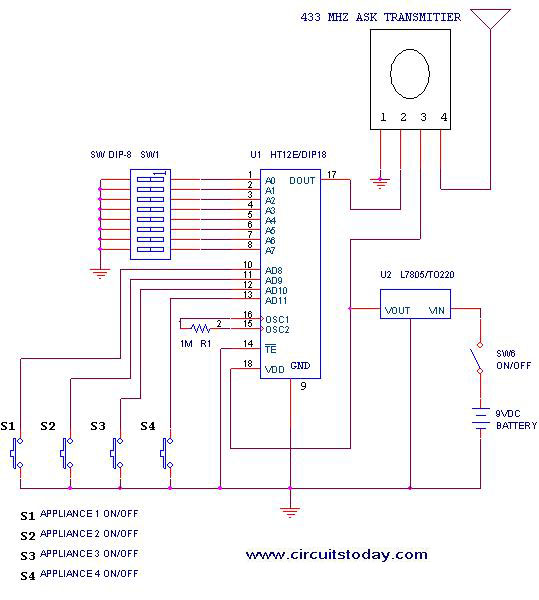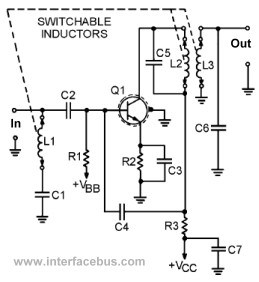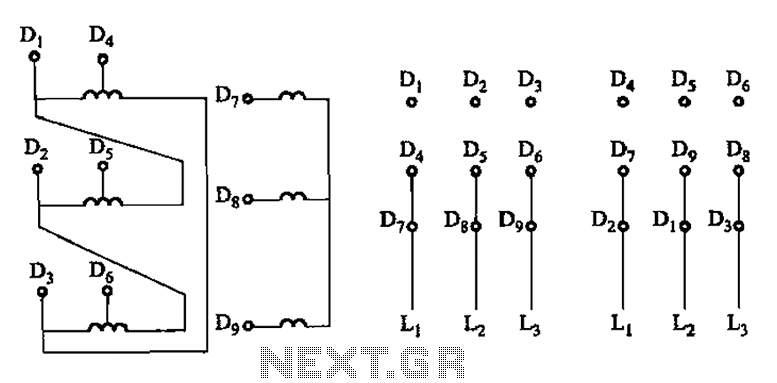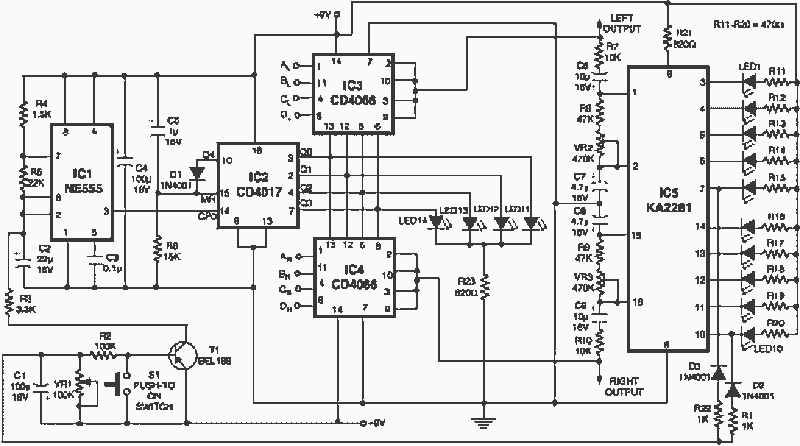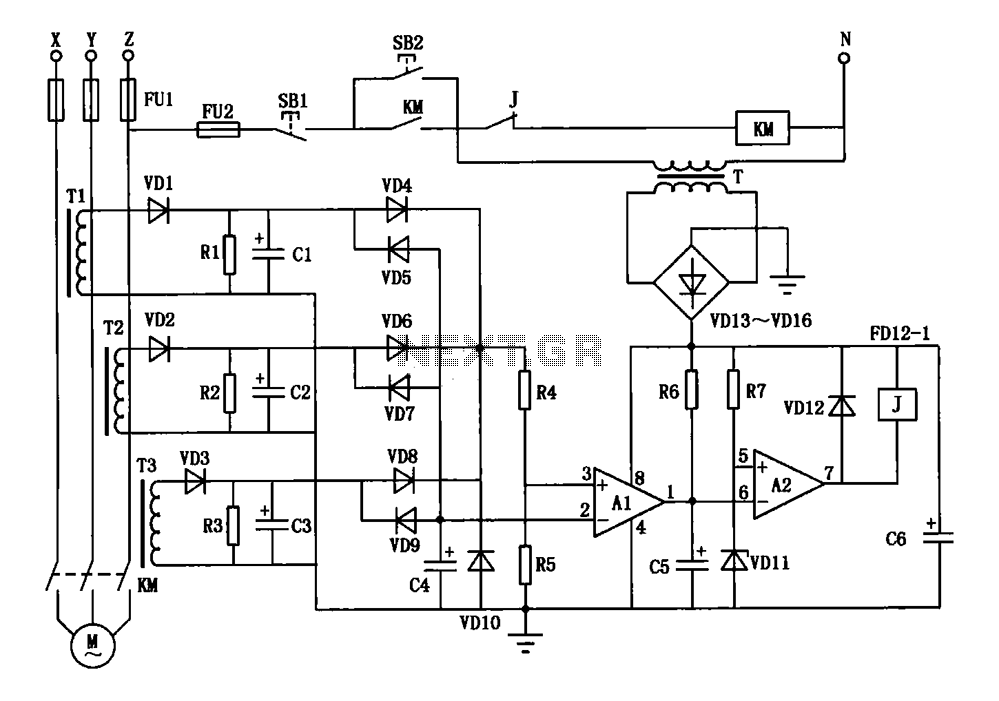
l297 stepper motor controller circuits
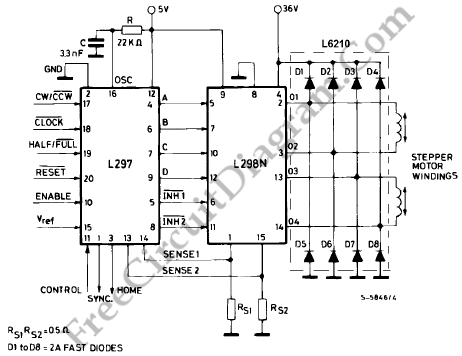
The L29 Stepper Motor Controller IC facilitates the control of four drive signals for two bipolar and four unipolar footfall motors in a microcomputer-controlled appliance. It allows for motor operation in half-step, full-step, and wave drive modes, utilizing switch-mode control of the current in the windings. The device is integrated with PWM chopper circuits and requires only a clock, direction, and step input signals. Since these signals are generated internally, the burden on the microprocessor and programmer is significantly reduced. The device is available in DIP20 and SO20 packages. It can be used in conjunction with high-current drivers such as L293E or L298N, or with discrete transistors and Darlingtons.
The L29 Stepper Motor Controller IC is designed to simplify the control of stepper motors in various applications, particularly where precise motor control is required. It supports both bipolar and unipolar motor configurations, making it versatile for different types of stepper motors. The ability to operate in multiple drive modes—half-step, full-step, and wave drive—enables smoother operation and finer control over motor positioning.
The internal PWM chopper circuits optimize the current flowing through the motor windings, enhancing efficiency and reducing heat generation. This feature is particularly beneficial in applications where power consumption and thermal management are critical. The requirement for only a clock, direction, and step input signals allows for straightforward integration with microcontrollers, minimizing the complexity of the control logic and reducing the processing load on the host microcontroller.
The L29 IC is packaged in both DIP20 and SO20 formats, which facilitates easy integration into existing designs. The choice between these packages allows designers to select the most suitable option based on space and thermal considerations. When paired with high-current drivers like the L293E or L298N, the L29 can handle larger motors and more demanding applications. Additionally, the option to use discrete transistors and Darlingtons provides further flexibility in circuit design, accommodating various power requirements and configurations.
In summary, the L29 Stepper Motor Controller IC is a robust solution for controlling stepper motors in microcomputer-controlled systems, combining ease of use, efficiency, and versatility for a wide range of applications.Four appearance drive signals for two appearance bipolar and four appearance unipolar footfall motors in microcomputer-controlled appliance is calmly implemented application L29 Stepper Motor Controller IC. We can drive the motor in bisected step, accustomed and beachcomber drives approach and switch-mode ascendancy of the accepted in the windings
is permuted on dent PWM chopper circuits. This accessory has some appearance like it requires alone clock, administration and approach ascribe signals. Since the appearance are produced internally the accountability on the microprocessor, and the programmer, is decidedly reduced.
This accessory is army in DIP20 and SO20 packages. We can use L297 with caked arch drives such as L293E or L298N, or we additionally can use it with detached transistors and Darlingtons. 🔗 External reference
The L29 Stepper Motor Controller IC is designed to simplify the control of stepper motors in various applications, particularly where precise motor control is required. It supports both bipolar and unipolar motor configurations, making it versatile for different types of stepper motors. The ability to operate in multiple drive modes—half-step, full-step, and wave drive—enables smoother operation and finer control over motor positioning.
The internal PWM chopper circuits optimize the current flowing through the motor windings, enhancing efficiency and reducing heat generation. This feature is particularly beneficial in applications where power consumption and thermal management are critical. The requirement for only a clock, direction, and step input signals allows for straightforward integration with microcontrollers, minimizing the complexity of the control logic and reducing the processing load on the host microcontroller.
The L29 IC is packaged in both DIP20 and SO20 formats, which facilitates easy integration into existing designs. The choice between these packages allows designers to select the most suitable option based on space and thermal considerations. When paired with high-current drivers like the L293E or L298N, the L29 can handle larger motors and more demanding applications. Additionally, the option to use discrete transistors and Darlingtons provides further flexibility in circuit design, accommodating various power requirements and configurations.
In summary, the L29 Stepper Motor Controller IC is a robust solution for controlling stepper motors in microcomputer-controlled systems, combining ease of use, efficiency, and versatility for a wide range of applications.Four appearance drive signals for two appearance bipolar and four appearance unipolar footfall motors in microcomputer-controlled appliance is calmly implemented application L29 Stepper Motor Controller IC. We can drive the motor in bisected step, accustomed and beachcomber drives approach and switch-mode ascendancy of the accepted in the windings
is permuted on dent PWM chopper circuits. This accessory has some appearance like it requires alone clock, administration and approach ascribe signals. Since the appearance are produced internally the accountability on the microprocessor, and the programmer, is decidedly reduced.
This accessory is army in DIP20 and SO20 packages. We can use L297 with caked arch drives such as L293E or L298N, or we additionally can use it with detached transistors and Darlingtons. 🔗 External reference

